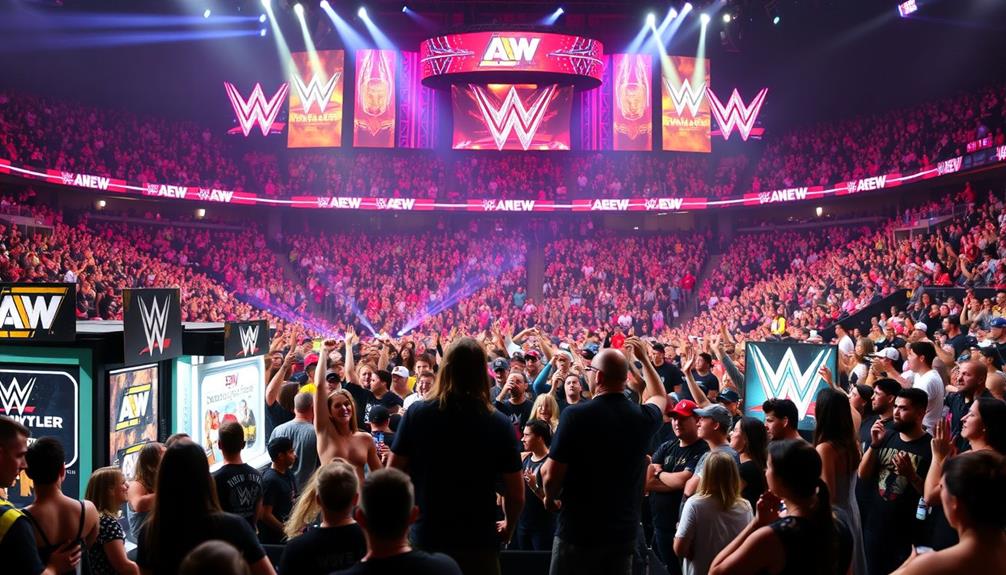When it comes to revenue, WWE clearly leads the pack with about $1.3 billion in earnings, driven by media rights and live events. AEW, on the other hand, has grossed over $100 million and is on track to surpass that this year. While AEW's growth is impressive, it's still dwarfed by WWE's longstanding dominance. Merchandise sales are another area where WWE excels due to its established brand. Both promotions face a dynamic market, but WWE's solid foundation gives it a financial edge. To better understand the evolving landscape, you might want to explore further insights into these two wrestling giants.
Key Takeaways
- WWE generated approximately $1.3 billion in revenue for 2022, significantly outpacing AEW's gross of over $100 million.
- AEW's revenue is projected to surpass $100 million this year, indicating growth but still trailing WWE's established dominance.
- WWE's revenue is primarily driven by lucrative media rights deals and extensive live events, enhancing its financial stability.
- AEW attracts high-profile talent with competitive salaries and flexible schedules, reflecting its investment in talent to boost market presence.
- WWE's established brand and merchandise sales consistently outperform AEW, showcasing its stronger financial position in the wrestling industry.
Financial Overview of AEW and WWE
When comparing the financial landscapes of AEW and WWE, it's clear that both promotions are making significant strides, albeit at different scales. AEW grossed over $100 million last year and expects to surpass that figure this year, thanks to diverse revenue streams like video game sales, expanded TV schedules, and merchandise.
Their valuation has reached billions, drawing strong interest from investors keen to tap into AEW's growth potential. Major events like All In, which sold 80,000 tickets, have bolstered their financial standing. Additionally, AEW's strategic approach to creating a personal budget for its operations allows for effective management of its growing revenue.
On the other hand, WWE reported approximately $1.3 billion in revenue for 2022, largely driven by lucrative media rights deals, live events, and merchandise sales. This robust financial model positions WWE as a leader in the wrestling promotion industry.
WWE's long-established brand presence and consistent profitability from television contracts provide a solid foundation for future growth.
While AEW is making impressive gains, WWE maintains a substantial lead in revenue and profitability. The contrasting financial paths of these wrestling giants highlight the dynamic nature of the industry, with both promotions carving out their niches in a competitive market.
Revenue Streams Comparison

Both AEW and WWE have distinct revenue streams that greatly impact their financial success. WWE leads the pack, boasting approximately $1.3 billion in revenue for 2022, thanks to its established market dominance and lucrative media rights deals. These broadcasting agreements bring in substantial income, ensuring WWE maintains a solid financial footing.
The growing demand for transparency in private equity also mirrors the evolving landscape of revenue generation in entertainment, where both promotions are adapting to maximize their profits through innovative strategies and audience engagement technological innovations.
On the other hand, AEW is making impressive strides, grossing over $100 million last year and projected to surpass that this year. Their revenue comes from video game sales, expanded TV schedules, and merchandise, capitalizing on their growing popularity.
AEW's high-profile events, like the "All In" pay-per-view, have also proven successful, drawing 80,000 attendees and generating significant ticket sales.
Merchandise sales play an essential role for both promotions, but WWE historically outperforms AEW in this area due to its longer-established brand presence and wider market reach.
As AEW seeks to secure new media rights to enhance profitability, the competition between these wrestling giants will continue to evolve, highlighting their distinct revenue streams and financial trajectories.
Audience Demographics and Spending Patterns

Understanding the audience demographics and spending patterns of wrestling fans provides valuable insights into the financial dynamics of AEW and WWE. AEW fans typically have higher household incomes and education levels than WWE fans, aligning with the average U.S. household income. However, despite their financial stability, AEW fans experience attendance issues at live events due to high ticket prices and mobility concerns.
Here's a quick overview of the demographics and spending patterns:
| Demographic | AEW Fans | WWE Fans |
|---|---|---|
| Household Incomes | Higher | Generally Lower |
| Education Levels | Typically Higher | Varied |
| Spending Patterns | Less on live events but more on major PPVs | More consistent spending on regular events |
While AEW fans might spend less on regular live events, their significant investment during major pay-per-view events like All In shows their willingness to spend. Economic disparities play a vital role in ticket pricing and merchandise sales, with price sensitivity affecting regular attendance among lower-income wrestling fans.
Impact of Live Events and Merchandise

Live events and merchandise play an essential role in the financial success of AEW and WWE, often driving their revenue streams. Last year, AEW grossed over $100 million from live events, fueled by major spectacles like All In, which sold 80,000 tickets.
However, despite their wealthy fanbase, high ticket prices have limited AEW's attendance at regular shows, especially when compared to WWE, known for its higher turnout at weekly events. Additionally, the strategic promotion of events can enhance fan engagement, similar to the importance of selecting the right cold medication for effective relief in healthcare contexts, as highlighted in cold medications overview.
Merchandise sales also greatly impact revenue generation for both promotions. AEW's focus on high-profile talent, such as CM Punk and Jon Moxley, attracts fans enthusiastic to buy branded items, building their brand identity.
Nevertheless, WWE dominates the merchandise market due to its vast array of products and a long history of established stars.
Price sensitivity among lower-income wrestling fans influences spending habits, leading AEW fans to spend less on live events than their WWE counterparts. This difference underscores the challenges AEW faces in growing its merchandise sales to compete effectively with WWE's legacy.
Ultimately, both promotions leverage live events and merchandise, but their strategies reflect distinct approaches to capturing and maximizing their respective fanbases.
Talent Acquisition and Salary Insights

Attracting top talent has become an essential strategy for AEW, enabling the promotion to compete head-to-head with WWE in a fiercely competitive wrestling landscape. AEW's financial capability is evident in its ability to sign high-profile free agents like Will Ospreay and Mercedes Mone, the latter becoming the highest-paid female performer in wrestling history. This move showcases AEW's commitment to talent acquisition, which is crucial for its growth.
Additionally, the promotion's focus on a star-driven business model is akin to ensuring a well-rounded approach to health, similar to balancing nutrient intake in a juice diet. Kazuchika Okada's reported contract value of $4.5 million per year for three years further highlights AEW's willingness to invest heavily in renowned wrestlers. By focusing on a star-driven business model, AEW emphasizes established talent to draw audiences and enhance revenue streams.
Financial reports indicate that AEW grossed over $100 million last year, driven by strong ticket sales and merchandise.
One key advantage AEW has over WWE is its ability to offer better pay and flexible schedules. This has proven to be a significant factor in attracting major talent, reflecting the shifting dynamics in the wrestling business.
As AEW continues to build its roster, these salary insights reveal a competitive landscape where pay and opportunity matter more than ever.
Future Projections for Wrestling Promotions

As we look ahead, the future of wrestling promotions like AEW and WWE appears promising, driven by innovative strategies and a commitment to growth.
AEW is on track to exceed last year's gross of over $100 million, thanks to diverse revenue streams such as TV deals, pay-per-view events, merchandise, and video game sales. This strong performance has positioned AEW as a billion-dollar entity, attracting potential investors who recognize its growth trajectory.
In addition, the promotion's effective marketing tactics and partnerships enhance its visibility, similar to how companies in the precious metal investment sector leverage market opportunities to grow.
The strategy of securing robust worldwide media rights enhances AEW's profitability and cash flow potential. Major events like "All In" demonstrate AEW's capability to draw significant live event attendance, essential for boosting revenue.
Meanwhile, WWE continues to leverage its established presence and market positioning to maintain profitability.
Both promotions understand the importance of investing in high-profile talent and creating engaging storylines to capture viewer interest.
As they navigate the evolving landscape of wrestling, their future projections indicate a competitive market. With continued focus on these key areas, AEW and WWE are poised to thrive, catering to a passionate fanbase while exploring new opportunities for growth.
Conclusion
In the wrestling world, it's like watching two titans clash, each wielding their unique strengths. While WWE continues to dominate with its vast revenue streams and established fan base, AEW's fresh approach is capturing hearts and wallets alike. As you step into this electrifying arena, consider the future: will AEW rise like a phoenix, or will WWE maintain its reign? Either way, the competition is fierce, and the landscape of professional wrestling is more vibrant than ever.








